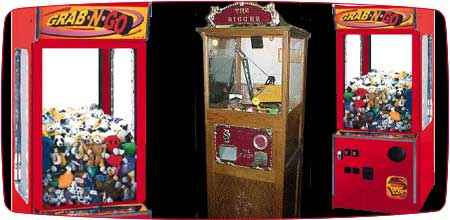Digger/Crane/Claw games

Retro Coin Op Synopsis
To give you an idea how long Digger/Crane machines have been shoveling in pennies and bigger coins, the original Digger machine featured no electric lights, as electric lights were still something of a novelty at the time.
First developed in 1896 (but not officially named until the turn of the century), The Erie Digger slowly won fans over to its simple test of skill. Using a mechanical control, players tried to dig up candy and other tiny prizes with the miniature crane encased behind glass and oak. Deft maneuvering of the crane led to a sweet reward, while the lesser-skilled were forced to pop in another penny and try again.
In the 1920’s, the Digger boom began in earnest. The Erie Digger (later simply renamed The Digger) had to compete with copycats like Iron Claw, Miniature Steam Shovel and Electro Hoist, many boasting new features like electric power and easier play. At around the same time, a new wrinkle sent Digger popularity into overdrive: gambling. In place of candy and toys, some Digger operators began placing cash rewards in the glass cases, and suddenly, mommy and daddy were playing a lot more of The Digger than junior was.
Digger machines continued to flourish through the 1930’s and 40’s, both on the gambling circuit and in traditional toy/prize venues like carnivals, fairs and arcades. These salad days came to a close, however, in the 1950’s, as tougher legislation made operating Diggers illegal in most cases. The gambling aspects were eliminated, and the machines were restricted to carnivals and such.
Some manufacturers compensated by turning Diggers into pure entertainment devices. In 1955, Williams introduced Crane, a modified version of the original Erie Digger concept. Instead of shoveling for prizes, players tried to scoop up gravel and drop it in a hopper. The “tonnage” of the gravel was measured by a meter inside the machine, and players raced to load as much gravel as possible before the timer ran out. Chicago Coin released a similar game, Steam Shovel, around the same time.
In the 1970’s, federal rules were relaxed a bit, and prize-offering Diggers began to reappear. The “dig for digging’s sake” concept lived on, however, in Americoin’s Junkyard, which allowed youngsters to live out their fantasies of operating a car crusher. The crane scooped up toy cars and loaded them into one of two hoppers, again racing the clock to load as many “tons” as possible.
As it turned out, the relaxed laws wouldn’t be enough to save the Digger from its fate. The wave of the future arrived in the early 80’s, taking the shape of a large, metal claw. Though similar in concept, Claw games offered more precise controls, run by advanced electronics. The prizes had been upped to match, usually involving some kind of stuffed animal or other soft toy. Players guided the claw to a (hopefully) rewarding location, then let the arms drop to reel in the bounty.
Claw games spread across the globe in the 1980’s and 90’s, popping up in restaurants, grocery stores, and of course, arcades. Whether controlled by buttons or joysticks, whether offering stuffed animals or baubles in plastic bubbles, Claw/Crane games continue to draw in players willing to test their skill, keeping the legacy of The Erie Digger alive and well into its third century.
Arcade Machine Release History
1896 - The Erie Digger1955 - Crane - Williams
Arcade Game Sub Categories
carnivalother
